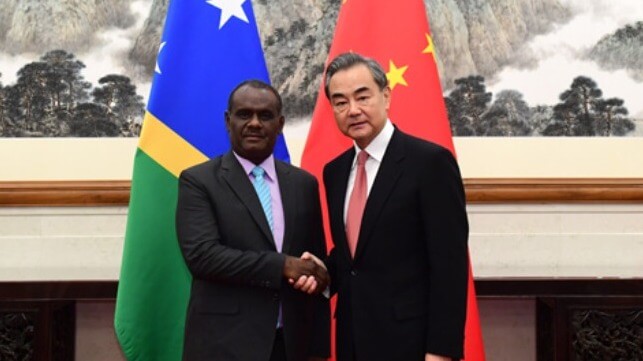China’s Proposal to Boost its Influence in the Pacific Islands

Months after announcement of a security agreement between China and the Solomon Islands, new details have emerged that China is also pursuing a Pacific-wide deal with almost a dozen of the island nations in the region. Some of the themes include maritime cooperation, cybersecurity and an education exchange program for over 2,000 workers and young diplomats from the Pacific.
The deal is contained in what appears to be a draft communique and five-year action plan, sent by Beijing to 10 Pacific island nations ahead of a Pacific tour by Chinese Foreign Minister Wang Yi.
The tour began on Thursday in the Solomon Islands, where Wang Yi formalized a recent security pact between the country and China. The tour is expected to end June 4 after a high-level regional leaders’ meeting scheduled to take place in Fiji.
However, Australia, the US, Japan and New Zealand share a common concern that China’s primary interest may be to create a stronger military foothold in the Pacific.
Wang Yi’s visit comes days after a meeting of the Quad nations (the US, Japan, Australia and India) in Tokyo. The topic of China’s growing influence in the Pacific was at the top of the agenda.
Is this a sign of China’s resolve to restructure the geopolitics of the Indo-Pacific region?
Some analysts argue that the deal with the Solomon Islands might have given China a window of opportunity to seek wider control of the Pacific Islands region.
But there are also signs that the bold approach could backfire. Last week, in a letter sent to 21 countries in the Pacific Rim, President David Panuelo of the Federated States of Micronesia sounded the alarm.
“The documents reflect an effort by China to acquire access and control of our region. The regional agreement includes language requiring that Pacific island countries abide by the ‘One China’ principle. Granting China greater access to the seas, lands, customs systems and digital networks of our countries could increase chances of China invading Taiwan and going to war with the United States, Japan, Australia and New Zealand,” argued President Panuelo.
Notably, the regional draft communique shows a number of shifts in China’s vision for the Pacific, according to an analysis by Dr. Anna Powles, a Senior Lecturer in Security Studies at Massey University in New Zealand.
First, the deal aligns economic cooperation with security cooperation. Thus, it creates a dilemma for Pacific countries seeking economic partnership with China. Interestingly, the deal proposes creation of China-Pacific Islands Free Trade Area, which if viewed from the draft’s language appears as a strategy to enhance China’s “security stakeholder status” in the Pacific.
Second, there is an apparent shift from bilateralism to multilateralism. The communique’s action plan states that China will appoint a Special Envoy for Pacific Island countries. The aim is to enhance China’s strategic cooperation with the island countries at a regional level. Notably, it would help align the Belt and Road Initiative with the Pacific Islands Forum’s 2050 Strategy for the Blue Pacific Continent.
Third, China wants more access to Pacific’s maritime domain. Specifically, China is seeking to expand its strategic interests in the Pacific for commercial fishing purposes.
“For example, China has majority fishing rights in Kiribati and when foreign minister Wang Yi visits this week it is widely expected that a series of fisheries deals will be signed,” noted Dr. Powles.
The opinions expressed herein are the author's and not necessarily those of The Maritime Executive.
